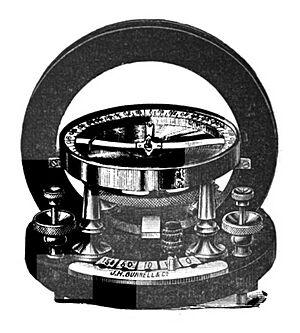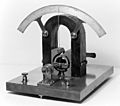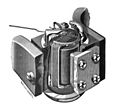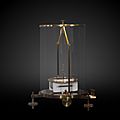Galvanometer facts for kids
A galvanometer is a clever tool used to find and measure electric current. Think of it as a special kind of meter that can show you if electricity is flowing and how much. It works by moving a pointer across a scale when electric current passes through it. This same basic idea is also used in other devices, like those that record information or help position things accurately.
How a Galvanometer Works
Most often, you'll see a galvanometer used as a simple meter. It helps us measure direct current (DC), which is electricity flowing in one direction, through an electric circuit.
Modern galvanometers, like the D'Arsonval/Weston type, have a small wire coil that can spin. This coil is placed near a strong, permanent magnet. A thin pointer is connected to the coil. This pointer moves across a scale that shows the amount of current. A tiny spring gently pulls the coil and pointer back to the zero position when no current is flowing.
When direct current (DC) flows through the coil, the coil creates its own magnetic field. This new magnetic field pushes against the field of the permanent magnet. This pushing makes the coil twist, working against the spring. As the coil twists, the pointer moves along the scale, showing you how much electric current is flowing.
The parts of the galvanometer are carefully designed so that the pointer's movement is directly related to the amount of current. This way, you can easily read the measurement. Good galvanometers also have a way to stop the pointer from wiggling too much, so it quickly settles on the correct reading.
Early Tangent Galvanometer
The tangent galvanometer was one of the first instruments used to measure electric current. It was invented by Claude Servais Mathias Pouillet in 1837. This older type of galvanometer uses a compass needle to compare the magnetic field created by the unknown electric current with the Earth's own magnetic field.
It gets its name from a rule called the tangent law of magnetism. This rule says that the angle a compass needle makes is related to the strength of two magnetic fields pushing against each other at right angles.
A tangent galvanometer has a coil of insulated copper wire wound in a circle. This coil stands upright on a flat base that can be leveled. The coil can also spin around its center. A compass is placed flat in the middle of the coil. Inside the compass is a small, strong magnetic needle that can spin freely.
The compass has a circular scale divided into four sections, each going from 0 to 90 degrees. A long, thin aluminum pointer is attached to the compass needle, sticking out at a right angle. To help you read the scale accurately and avoid mistakes, there's a mirror placed under the compass needle.
Images for kids
-
A galvanometer mechanism (center part), used in an automatic exposure unit of an 8 mm film camera, together with a photoresistor (seen in the hole on top of the leftpart).
See also
 In Spanish: Galvanómetro para niños
In Spanish: Galvanómetro para niños












